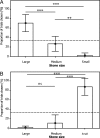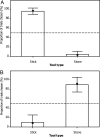Insightful problem solving and creative tool modification by captive nontool-using rooks
- PMID: 19478068
- PMCID: PMC2700937
- DOI: 10.1073/pnas.0901008106
Insightful problem solving and creative tool modification by captive nontool-using rooks
Abstract
The ability to use tools has been suggested to indicate advanced physical cognition in animals. Here we show that rooks, a member of the corvid family that do not appear to use tools in the wild are capable of insightful problem solving related to sophisticated tool use, including spontaneously modifying and using a variety of tools, shaping hooks out of wire, and using a series of tools in a sequence to gain a reward. It is remarkable that a species that does not use tools in the wild appears to possess an understanding of tools rivaling habitual tool users such as New Caledonian crows and chimpanzees. Our findings suggest that the ability to represent tools may be a domain-general cognitive capacity rather than an adaptive specialization and questions the relationship between physical intelligence and wild tool use.
Conflict of interest statement
The authors declare no conflict of interest.
Figures






Comment in
-
Tools for thought or thoughts for tools?Proc Natl Acad Sci U S A. 2009 Jun 23;106(25):10071-2. doi: 10.1073/pnas.0904735106. Epub 2009 Jun 16. Proc Natl Acad Sci U S A. 2009. PMID: 19541623 Free PMC article. No abstract available.
-
Insight learning or shaping?Proc Natl Acad Sci U S A. 2009 Jul 14;106(28):E76; author reply E77. doi: 10.1073/pnas.0906120106. Epub 2009 Jul 1. Proc Natl Acad Sci U S A. 2009. PMID: 19571011 Free PMC article. No abstract available.
Similar articles
-
Rooks use stones to raise the water level to reach a floating worm.Curr Biol. 2009 Aug 25;19(16):1410-4. doi: 10.1016/j.cub.2009.07.033. Epub 2009 Aug 6. Curr Biol. 2009. PMID: 19664926
-
Compound tool construction by New Caledonian crows.Sci Rep. 2018 Oct 24;8(1):15676. doi: 10.1038/s41598-018-33458-z. Sci Rep. 2018. PMID: 30356096 Free PMC article.
-
New Caledonian crows rapidly solve a collaborative problem without cooperative cognition.PLoS One. 2015 Aug 12;10(8):e0133253. doi: 10.1371/journal.pone.0133253. eCollection 2015. PLoS One. 2015. PMID: 26266937 Free PMC article.
-
Animal cognition: crows spontaneously solve a metatool task.Curr Biol. 2007 Oct 23;17(20):R894-5. doi: 10.1016/j.cub.2007.08.028. Curr Biol. 2007. PMID: 17956752 Review.
-
Is primate tool use special? Chimpanzee and New Caledonian crow compared.Philos Trans R Soc Lond B Biol Sci. 2013 Oct 7;368(1630):20120422. doi: 10.1098/rstb.2012.0422. Print 2013 Nov 19. Philos Trans R Soc Lond B Biol Sci. 2013. PMID: 24101630 Free PMC article. Review.
Cited by
-
How far will a behaviourally flexible invasive bird go to innovate?R Soc Open Sci. 2016 Jun 15;3(6):160247. doi: 10.1098/rsos.160247. eCollection 2016 Jun. R Soc Open Sci. 2016. PMID: 27429781 Free PMC article.
-
Performance in Object-Choice Aesop's Fable Tasks Are Influenced by Object Biases in New Caledonian Crows but not in Human Children.PLoS One. 2016 Dec 9;11(12):e0168056. doi: 10.1371/journal.pone.0168056. eCollection 2016. PLoS One. 2016. PMID: 27936242 Free PMC article.
-
How Insightful Is 'Insight'? New Caledonian Crows Do Not Attend to Object Weight during Spontaneous Stone Dropping.PLoS One. 2016 Dec 14;11(12):e0167419. doi: 10.1371/journal.pone.0167419. eCollection 2016. PLoS One. 2016. PMID: 27973610 Free PMC article.
-
The development of support intuitions and object causality in juvenile Eurasian jays (Garrulus glandarius).Sci Rep. 2017 Jan 5;7:40062. doi: 10.1038/srep40062. Sci Rep. 2017. PMID: 28053306 Free PMC article.
-
Opportunistic Tool Use by Two Unexpected Corvid Species.Ecol Evol. 2025 May 11;15(5):e71314. doi: 10.1002/ece3.71314. eCollection 2025 May. Ecol Evol. 2025. PMID: 40357133 Free PMC article.
References
-
- Beck BB. Animal Tool Behaviour. New York: Garland Press; 1980.
-
- van Schaik CP, Deaner RO, Merrill MY. The conditions for tool use in primates: Implications for the evolution of material culture. J Hum Evol. 1999;36:719–741. - PubMed
-
- Seed AM, Call J, Emery NJ, Clayton NS. Chimpanzees solve the trap problem when the confound of tool use is removed. J Exp Psychol. 2009;35:23–34. - PubMed
-
- Povinelli DJ. Folk Physics for Apes. New York: Oxford Univ Press; 2000.
-
- Seed AM, Tebbich S, Emery NJ, Clayton NS. Investigating physical cognition in rooks, Corvus frugilegus. Curr Biol. 2006;16:697–701. - PubMed
Publication types
MeSH terms
Grants and funding
LinkOut - more resources
Full Text Sources

